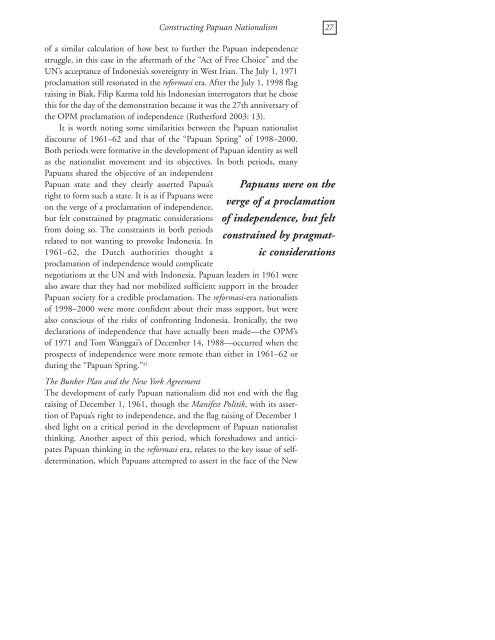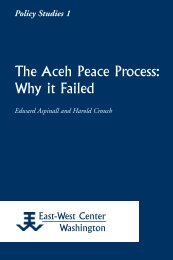Constructing Papuan Nationalism: History, Ethnicity ... - ScholarSpace
Constructing Papuan Nationalism: History, Ethnicity ... - ScholarSpace
Constructing Papuan Nationalism: History, Ethnicity ... - ScholarSpace
- No tags were found...
You also want an ePaper? Increase the reach of your titles
YUMPU automatically turns print PDFs into web optimized ePapers that Google loves.
<strong>Constructing</strong> <strong>Papuan</strong> <strong>Nationalism</strong> 27of a similar calculation of how best to further the <strong>Papuan</strong> independencestruggle, in this case in the aftermath of the “Act of Free Choice” and theUN’s acceptance of Indonesia’s sovereignty in West Irian. The July 1, 1971proclamation still resonated in the reformasi era. After the July 1, 1998 flagraising in Biak, Filip Karma told his Indonesian interrogators that he chosethis for the day of the demonstration because it was the 27th anniversary ofthe OPM proclamation of independence (Rutherford 2003: 13).It is worth noting some similarities between the <strong>Papuan</strong> nationalistdiscourse of 1961–62 and that of the “<strong>Papuan</strong> Spring” of 1998–2000.Both periods were formative in the development of <strong>Papuan</strong> identity as wellas the nationalist movement and its objectives. In both periods, many<strong>Papuan</strong>s shared the objective of an independent<strong>Papuan</strong> state and they clearly asserted Papua’sright to form such a state. It is as if <strong>Papuan</strong>s wereon the verge of a proclamation of independence,but felt constrained by pragmatic considerationsfrom doing so. The constraints in both periodsrelated to not wanting to provoke Indonesia. In1961–62, the Dutch authorities thought aproclamation of independence would complicatenegotiations at the UN and with Indonesia. <strong>Papuan</strong> leaders in 1961 werealso aware that they had not mobilized sufficient support in the broader<strong>Papuan</strong> society for a credible proclamation. The reformasi-era nationalistsof 1998–2000 were more confident about their mass support, but werealso conscious of the risks of confronting Indonesia. Ironically, the twodeclarations of independence that have actually been made—the OPM’sof 1971 and Tom Wanggai’s of December 14, 1988—occurred when theprospects of independence were more remote than either in 1961–62 orduring the “<strong>Papuan</strong> Spring.” 42<strong>Papuan</strong>s were on theverge of a proclamationof independence, but feltconstrained by pragmaticconsiderationsThe Bunker Plan and the New York AgreementThe development of early <strong>Papuan</strong> nationalism did not end with the flagraising of December 1, 1961, though the Manifest Politik, with its assertionof Papua’s right to independence, and the flag raising of December 1shed light on a critical period in the development of <strong>Papuan</strong> nationalistthinking. Another aspect of this period, which foreshadows and anticipates<strong>Papuan</strong> thinking in the reformasi era, relates to the key issue of selfdetermination,which <strong>Papuan</strong>s attempted to assert in the face of the New
















